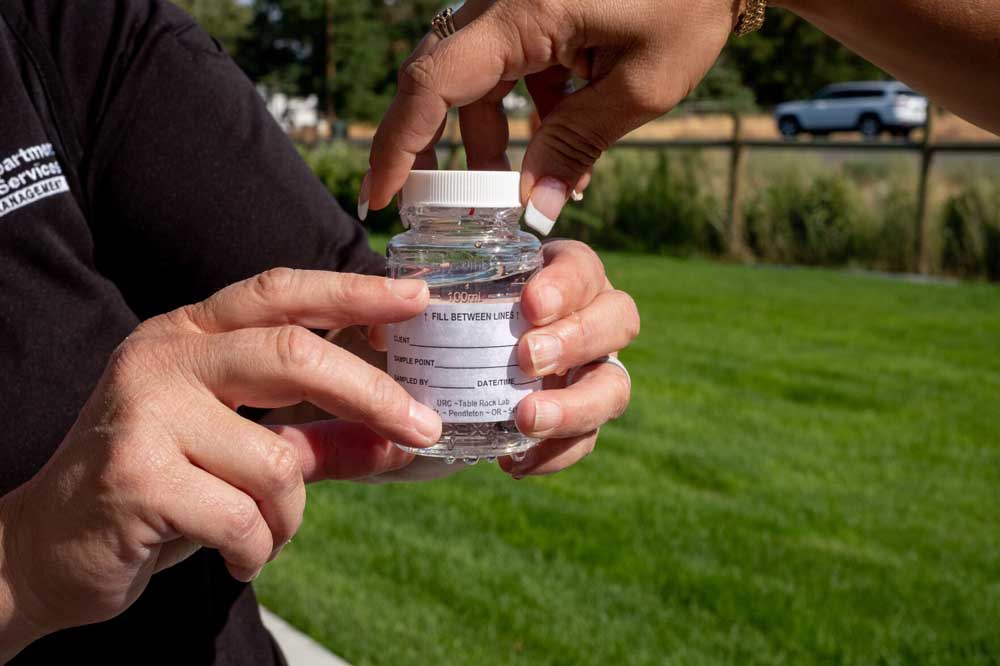State workers visit homes in Eastern Oregon to test for contaminated water
Published 9:00 pm Monday, August 28, 2023

- Wight holds a bottle for testing Wednesday at a home in Umatilla.
UMATILLA — Canvassers went door to door last week, Aug. 25, in Umatilla to test groundwater for nitrate levels and to continue to raise awareness about well-water contamination.
The Oregon Department of Human Services and the Oregon Health Authority have partnered with local organizers, as well as the office of Oregon Gov. Tina Kotek, to address high-nitrate levels in groundwater in Umatilla and Morrow counties. Nitrate levels exceeding 10 milligrams per liter can cause serious health risks if consumed, according to the federal government. In some cases, home tests by area residents have shown nitrates at four to five times that level.
Canvassers, who also worked Saturday, Aug. 26, in Boardman, offered free well tests and handed out instant tests well users can administer at home.
“We tried a few different methods of outreach,” said Shelly Wight, regional emergency coordinator for the state human services Office of Resilience and Emergency Management. “We found that in this community, canvassing worked best.”
Other methods of reaching rural residents who may have contaminated wells have proven difficult, Wight said, whereas the door-to-door approach has gotten several hundred well tests scheduled since they began canvassing in early July.
Canvassers worked in two shifts, bringing information about well-water nitrate contamination and offering to collect samples for testing on the spot or to schedule appointments to do so later, Wight said. Then, canvassers return their samples to the state van, which keeps them cool and transports the samples to testing.
“It’s also helpful because we have a large Spanish-speaking population here,” Wight said. “Every canvassing team has two people, and one of them is always fluent in Spanish. We want people to be able to communicate with us immediately and eliminate barriers.”
Feedback to the canvassing team has been positive, Wight said, but she has observed the problem isn’t residents who don’t want to test their wells, but rather residents who were unaware of the problem existing in the first place.
Anca Matica, press secretary for Kotek, said the effort is about helping people get access to clean water above all else.
“We found that canvassing works really well, we get people’s information and we help them get clean water,” she said. “Long-term solutions will come down the line, but we’re fully engaged here after the governor’s visit earlier this year.”
Canvassers across Hermiston and Umatilla wore dark blue shirts that asked, “Is your water safe?” in English and Spanish, which Wight said she hoped would help people recognize the canvassers and be willing to speak to them.
“They call us the water people,” Wight said with a laugh. “I’m good with that.”
Access to expertsAfter the door-to-door work, the state agencies held a public forum at Clara Brownell Middle School in Umatilla with scientists and representatives from a multitude of involved agencies to educate the public on the issue.
Shawn Finn, a well inspector with the Oregon Water Resources Department, shared information about well contamination through a model using standard aquarium parts, which showed a cross-section of how underground water wells work, and demonstrated how easily they can be contaminated.
“People don’t realize how a single septic tank can flow through an aquifer and affect all of the surrounding groundwater,” he said. “This model helps them visualize it. They often ask, how can you fix it? The answer is that it depends on where you are and what makes up the aquifer. That’s when the real work begins.”
Across from Finn, Oregon Rural Action handed out test kits with instructions in English and Spanish that individuals in attendance could take home to test their own groundwater.
“We’ve been asking the state to provide these tests for free for a while,” said Kristin Ostrom, Oregon Rural Action executive director. “Now the state is providing them, and we have all of these resources to help the community. We’re thankful for the community action, and hope to keep this good work up in the future.”
Throughout the forum, dozens of visitors came through and collected test kits, informational pamphlets and even “edible aquifers,” proving to be what Ostrom described as a strong turnout.
Even so, she said, there remains a lot of work to do.








